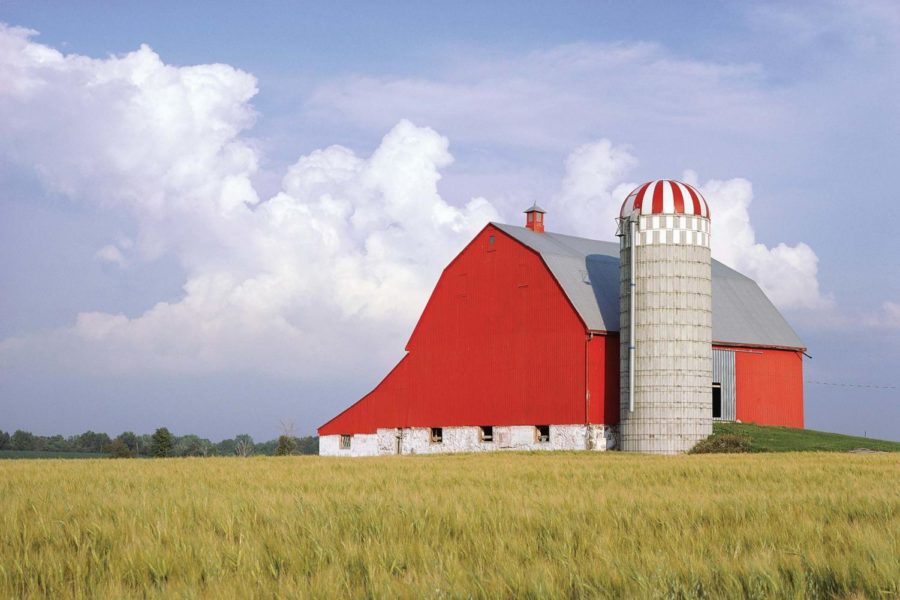Cline: Farming, agriculture are about more than laying waste to land
Most farmers are not trying to destroy the environment to make ends meet. The vast majority of farm families farm because they love to do it.
October 7, 2011
“When did agriculture become a dirty word?” This question has adorned the pages of the New York Times and is becoming a trendy topic on sites across the Internet. As a proud member and supporter of the agriculture industry, it got me thinking, when did we become the bad guys?
As a society, we have turned against the industry that has sustained and supported our country for centuries. We have no qualms about tearing down agriculturalists and looking down on farmers.
Often times just hearing the word “farmer,” the connotation that seemingly comes to mind is someone who is dirty and uneducated, like a character fresh out of the “Green Acres” television series.
While there are some corporations, organizations and individuals that feel no guilt in brutalizing their land or animals in order to make a buck, we must draw the line and not victimize the hard-working families that work to support themselves and our society. Not all farms are run the same way, and the average American farmer takes pride in caring for his livestock and produce.
One of the biggest issues facing the traditional family-owned farms that comprise 87 percent of total U.S. farms, according to the USDA, is teaching people the difference between themselves and factory farms.
Concentrated Animal Feeding Operations, as these industrialized operations are known, have become the characterization of the modern American farm in the media. Images are often released of abusive owners, lame animals and poorly maintained facilities in these setups. These farms have given everyone a bad name and are often condemned by a majority of agriculturalists.
In the documentary “Food Inc.,” the producers of the film further perpetuate this stereotype. The scenes are hard to stomach and some of the actions are egregious, but again it is a slanted view of modern agriculture.
Recently, representatives from Mercy for Animals and Vegan Outreach passed out pamphlets scrutinizing agriculture, specifically meat production. The decision to be vegan or vegetarian is a personal choice, but using propaganda to convince others of a viewpoint detracts from the ethical standard allegedly set by saving animal’s lives.
According to the organization’s material, all animals are deprived of adequate food and housing. Why would this be the case if farmers were looking to profit from said livestock? Farmers spend extensive time and money on animal welfare and treatment from professional veterinarians. On dairy farms, for example, facilities are checked by certified inspectors and farms not meeting the standard are not allowed to sell their milk.
Farmers that take better care of their animals take better care of themselves. Thanks to advances in science and technology, farmers are better able to care for animals from birth to maturity. With less inputs and increased understanding, producers are able to provide sufficient lifestyles with less stress on the animals.
According to the Wisconsin Milk Marketing Board, 75 percent of dairy herds in the “Cheese State” operate with less than 100 head of cattle. In order to be viewed as one of the aforementioned factory farms, a dairy operation would have no less than 500 heads. Even with the small size, producers have enhanced output by 25 billions pounds in the past decade. This is again in thanks to better technology providing greater feed efficiency, herd health and longer life spans.
Working to satisfy global demand with diminishing resources has also become a concern for farmers across the spectrum. According to the American Farmland Trust, from 1982 to 2007, 41 million acres of land were removed from production, in favor of development. The land loss was not just in crops and cattle, but also wetlands, forests and environmental safeguards put in place by farmers. The loss was approximately equal to the size of Illinois and New Jersey combined.
In spite of this lack of land area, the United States continues to set the bar for global production. In data from the U.S. Census Bureau, 41 percent of the world’s soy production came from America, as well as 35 percent of the soybeans. Globally, crop production was up across the board.
Environmental protection is another growing concern for everyone in agriculture. People perceive farming a major pollutant, primarily from cattle manure and fertilizer run off. The growth of organic farms, up by roughly 4,000 operations since 2006, combined with the advancement of crop chemicals that are more environmentally friendly, has spurred the reclamation and improvement of ecosystems adjacent to farm land.
To further help alleviate the burden, the National Resource Conservation Service continues to promote the Conservation Reserve Program. The CRP was created to turn once-tillable acres back into natural grasslands that prevent soil erosion. Along with implementing riparian buffer zones to alleviate chemical runoff, farmers have jumped into the driver seat on environmental protection.
Take a trip down a gravel road in the Midwest. There are not abusive corporate owners aiming to destroy the environment and subject animals to cruelty just to make a buck. No matter when or where, there are farms and farm families looking to make a living doing something they love. In few industries are there individuals with a passion and dedication to their work comparable to agriculture.
Perhaps a better question to ask than “when did agriculture become a dirty word?” is the classic “what would you be without agriculture?”
Answer: Hungry and naked.

















